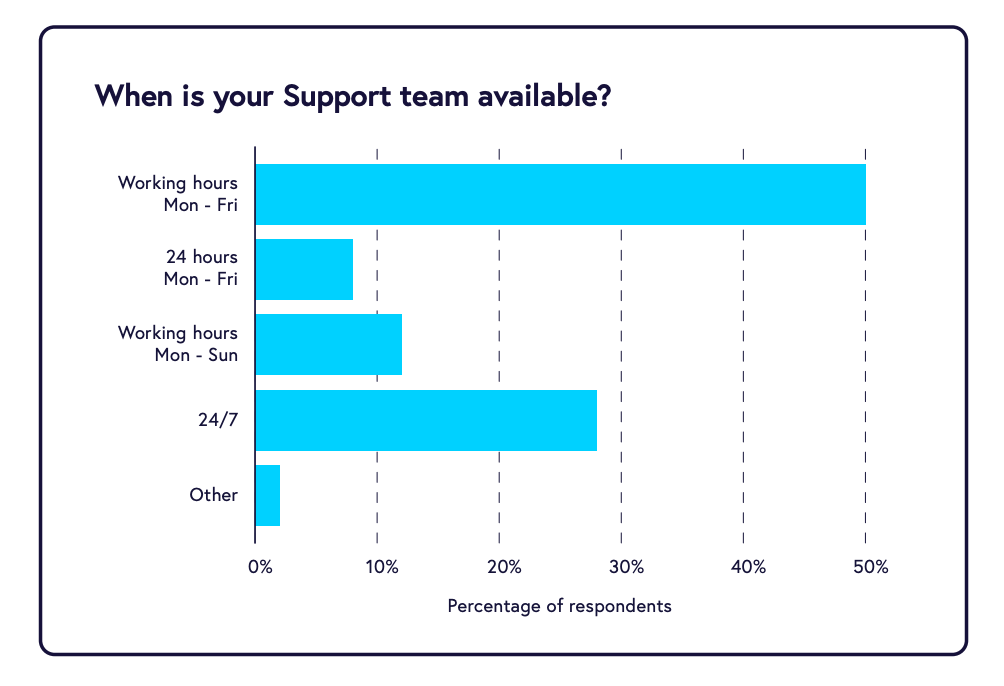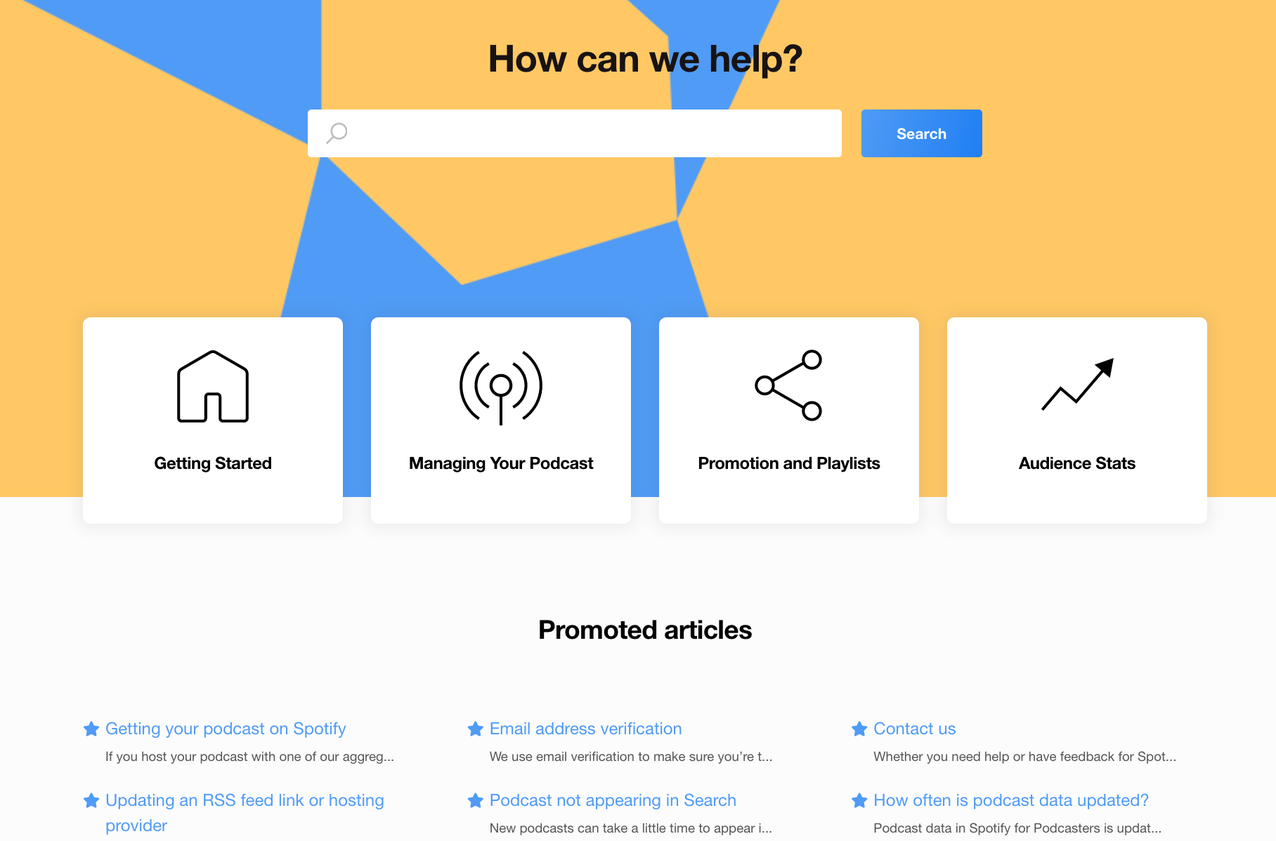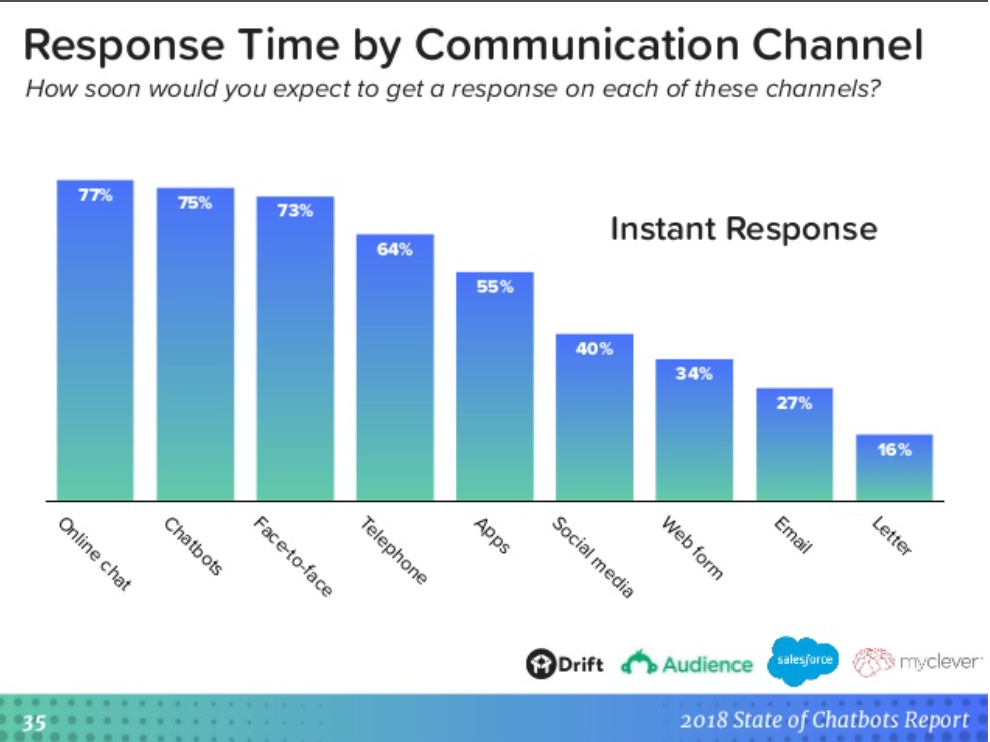According to KPMG, 58% of consumers say being able to shop 24/7 is the number one reason they shop online. Companies have international customer bases who are online round-the-clock, and that means a decent chunk of customers will be disappointed if they can’t receive help during off-hours.
The Geckoboard Customer Support Experience Report 2021 found that 50% of customer support teams are only available during business hours Monday to Friday, and only 28% are available 24/7. While it’s possible to grow your business without providing 24/7 support, companies should consider the benefits to the customer experience that round-the-clock support provides.
The pros and cons of providing 24/7 support
24/7 support is a big investment for any company. You need to hire and train more support reps, which requires financial investment upfront before you experience the benefits of having your support team available 24/7.
If you’re looking to scale up to offering round-the-clock support coverage, consider the pros and cons of doing so before you make a firm decision.
Pros
The biggest benefit of offering 24/7 support is that you provide a more convenient service for your customers. In an always-on world, providing round-the-clock support means your service meets customer expectations, and they can contact you whenever they need you.
A 24/7 support team is also better equipped to handle support queries sooner than a team that’s only available 9-to-5 because you have more reps available to tackle your support queue. When you implement 24/7 support, you’re likely to see your First Response Time and Average Resolution Time drop as your support team is available round-the-clock, which means they can respond to your customers more quickly.
It also means you can serve and support a global customer base. Offering 24/7 support makes it possible for your company to grow its customer base outside your home region. If you’re only offering support 9-to-5, Monday to Fridaylocally, then international customers in different time zones will struggle to contact your support team and are more likely to abandon your brand.
Rolling out 24/7 support can also push companies to adopt new technology to improve their support team’s efficiency. When companies first start offering 24/7 support, they look for tools and technology to help them increase their team’s productivity while bringing on new team members. This can mean implementing chatbots, automating ticket routing, or rolling out canned email responses—all of which can be used by other teams in your business as they see the benefits it brings to your support team.
Cons
The biggest drawback to providing round-the-clock support is needing a bigger support team. To provide 24/7 support, you’ll need to hire more support reps, which means higher staffing costs.
Round-the-clock support can also be a logistical challenge if you don’t have international offices. You’ll need to outsource out-of-hours support to a third-party service (which can take some time to set up and train), hire team members to work night shifts (which means bigger office utility bills and may bring added costs such as office security), or hire remote team members in different timezones (which has tax implications, but also brings opportunities for growth and innovation).
Companies should also keep in mind that providing 24/7 support isn’t always necessary. There are alternatives: You could add support during business hours on Saturday and Sunday to increase your support coverage, or you could offer 24-hour support on weekdays. So before you roll out 24-hour support coverage for the entire week, take the time to analyze your support volumes and peak times. Cross-reference this data with your team’s availability, and identify which changes can have the biggest impact on ticket backlog and customer wait times.
Should my business offer 24/7 support?
In our always-on world, you might think that offering 24/7 support is an inevitable part of growing your business. But it depends on your company, your industry, and your customer base. Here are three indicators that 24/7 support is the right option for your business.
You’re serving a global customer base
If your customers are spread across multiple time zones, only offering 9-to-5 support in your local time will put your international customers at a disadvantage. If your company starts expanding into new regions, or you see a sharp increase in international orders, that’s a clear signal that your business should consider providing round-the-clock support.
Your industry requires 24/7 support
While many consumers have adopted 24/7 buying habits, that’s a matter of convenience rather than necessity. But in some industries—like healthcare, travel, insurance, or security—customers truly need to be able to contact you any time of the day or night. When customers in these sectors need support, they likely need it immediately (or as soon as possible).
Most of your support queries come in after-hours
If most of your support tickets come in after-hours, that’s a clear sign that offering 24/7 support would be beneficial for your customers. A large volume of overnight tickets will create a backlog the next day if you don’t offer round-the-clock service.
What can your business do instead of offering 24/7 support?
If the signs above aren’t true for your business, it’s possible that 24/7 support isn’t the right option for your business. Round-the-clock support is a significant investment, so consider other ways to provide a great experience for your customers:
- Extend support availability beyond your typical 9-to-5 hours on some days, but not the entire week
- Provide self-service support options such as FAQs to address your most common queries or a support community forum where customers can ask and respond to each other’s questions
- Focus on improving your average resolution time, so your team can handle more tickets when they are available

Four tips for providing 24/7 support
If you have a global team, you might be able to provide 24/7 support coverage quite easily thanks to having team members in different time zones. But if you’re in one location, here are four tips for scaling up to offering 24/7 support while maintaining a high quality of customer service.
Start by extending hours beyond 9-to-5
Extend your support availability gradually, rather than jumping straight to 24/7 support. You might start by adding support during the weekend and in the evenings if your business receives similar levels of support queries year-round.
But if your business experiences seasonal increases in customer queries (like over the Christmas holiday season for ecommerce businesses), you could also try offering extended hours or bringing on temporary additional team members for your company’s peak time periods.
While 28% of companies who responded to our Customer Support Experience Report provided 24/7 support, 12% are available during business hours Monday to Sunday. A further 8% are available 24 hours a day, Monday through Friday. There are plenty of ways to offer support beyond 9-to-5 before you fully scale up to round-the-clock support coverage.

Offer extended support coverage for a few months to measure how that affects your backlog before you scale up to providing round-the-clock support. It might be that providing support for longer periods during the week or bringing on a weekend customer support team is enough to solve your backlog.
Provide self-service options
One of the simplest ways to scale up your support offering is to help your customers help themselves—and each other. A knowledge base or FAQs page can reduce the number of tickets your support team handles by empowering customers to find the answers to their most common questions.
Spotify for Podcasters provides a searchable help center so customers can find answers to frequently asked questions like “how often is podcast data updated?” or challenges like “podcast not appearing in search.”

Alternatively, InVision has a support community forum where customers can provide product feedback and share tips and best practices. A forum makes your customers an extended part of your support team. It also means you can identify the “power users” of your products or services who might be a good fit for customer testimonials or case studies.

Automate as much as possible
Automating repetitive but time-consuming tasks frees up your support agents to tackle more complex tickets. One respondent in our Customer Support Experience Report shared that introducing automation was one of the biggest improvements they’d made to their customer experience recently.
“We introduced some automation initiatives for topics like account management and refunds. These topics aren’t value-adding but required steps that didn’t need to be done by an agent,” said one customer support manager in The Geckoboard Customer Support Experience Report 2021.
But when automating some of your customer support, remember to consider the customer’s experience. Where possible, focus on automating your behind-the-scenes processes such as ticket routing and workflows so that your support still has a personal touch and you’re not compromising on quality.
“We introduced some automation initiatives for topics like account management and refunds. These topics aren’t value-adding but required steps that didn’t need to be done by an agent.”
Focus on the channels that matter most
Customers have different expectations around response times depending on the support channel they used to contact you. Drift’s 2018 State of Chatbots Report found that over 75% of customers expect an instant response if they contact you via chatbot or online chat, and fewer than 10% of customers expect to wait more than 24 hours for a response if they contact a company by phone, social media, or online chat.

When you’re scaling up to offer 24/7 support, don’t feel like you need to offer round-the-clock support across all channels at once. Focus on the channels where customers expect to hear back from you soonest so that you’re meeting customers’ expectations with your service.
Ask your support team for feedback
Your customer support team members are best placed to understand how much offering round-the-clock support will improve the quality of service you’re providing. They’re the first to feel the pain when support queues grow and customer wait times increase.
Track first response time, average resolution time, ticket volume, and ticket backlog to keep an eye on your support team’s workload and performance so you understand how your support load is growing over time. This data, along with your support team’s anecdotal feedback, will help you determine when it’s best to start providing 24/7 coverage.


